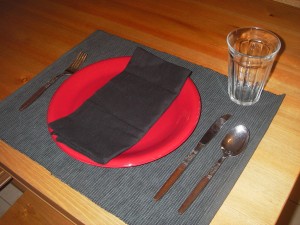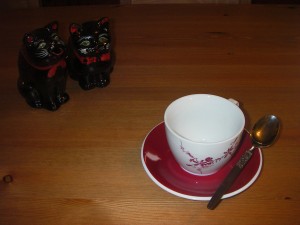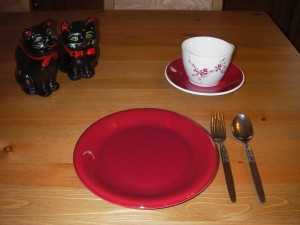From the time I first entered my adult life until now, I have watched the traditional consistencies of my Christmases past fade away – as every holiday I have witnessed henceforth has been celebrated in a delightfully strange new way. From family members leaving us and joining us to graduating from the kids table to embracing a new family of in-laws, the way the holidays are celebrated by the modern twenty-something is ever-changing, spawning new and unique experiences and soon-to-be traditions every year. What if this is the year you find out you have gotten that big promotion to table setter as your grandmother hands you a weird briefcase full of her finest silverware, or it’s your first time dining with a boyfriend’s family and they have their own customs, different from that of your family, or, scariest of all, it’s your first time hosting? Luckily, we have cultural standards to rely on and save us from the embarrassment that comes from our inexperience.
The one thing that doesn’t change from family to family is proper table setting. Though they seem odd and needlessly complicated at times, table setting rules are universally observed because they were developed for the way food is eaten and served. Unfortunately for left-handers, the laws of probability condemned all those involved with creating these rules to be right handed, therefore, all rules favour making things easier for the right-handers but not necessarily so for the left-handers. The basic, can’t go wrong rules are: the knives always go on the right, closest to the plate, with their sharp side towards the plate and the spoons always go on the right, further from the plate than the knives. The forks are a little trickier. Most of the forks, most of the time, go on the left of the plate. The exceptions are the seafood fork, which goes on the right, furthest to the right and the dessert fork, which is put in the place of the knife if the knife is not needed for the dessert course. The dessert fork and spoon can also be place above the plate, with the spoon on top, pointing left and the fork below the spoon, pointing right, if you please. When setting the utensils order is important, the pieces that will be used first are placed closer to the outside, in the proper districts, in the order they will be used. The knives are placed closer to the plate even though they are frequently used before the spoons because of the tendency for people to constantly pick them up and set them down again while they dine. For more formal, marathon style meals it is common practice to place no more than three utensils on each side of the plate. If more are needed, they will be brought out with their corresponding course.
The appropriate glass for the beverage being served during the main course, usually wine, is set precisely half an inch above the point of the main course knife. There are different glasses for both red and white wines, if serving both, both need to be set. Though it is not necessary to set both red and white wine glasses if only one will be served, you do need to set a water and wine glass for every person if any kind of wine will be served. For formal occasions a stemmed glass for water is preferred but a regular tumbler type glasses is suitable for casual meals. Additional glasses are set on an ascending diagonal from the main course glass, with the water glass at the top and any glasses used before the main course set on the same diagonal, on the other side of the main course glass. As with the utensils, the maximum-of-three rule applies. No more than three different glasses should be set, even if more beverages will be served. Again, the fresh glasses will be brought out when needed.
At my family Christmas dinner the utensils are set around a paper plate, at more formal meals, however, they are set around a charger plate. The charger is a large plate that sets each place before the guests sit down; it also holds the appetizer plate and soup bowl when they come. The proper distance to leave between chargers is 30 inches from the centre of one to the centre of the next; this space will ensure that guests have sufficient elbow room – even the left-handers. The bread plate, also called the butter plate, is placed to the upper left of the setting, with a butter knife placed on the right edge of the plate. Coffee or tea cups, saucers and spoons are usually not set until the dessert course, when setting, the cup goes on the saucer, set so that its handle is parallel to the teaspoon that rests on the bottom right corner of the saucer.
An improperly placed napkin can make the fanciest of meals look sloppy. To avoid this predicament, place a simply folded cloth napkin to the left of the plate, under the forks or to their left. For more casual atmospheres, it is acceptable to put the napkins on the plates. It is not necessary, or even acceptable in most cases, to fold the napkins in swan, dinosaur or any other decadent shape. A napkin folded over on its self a few times and set with open corners to the bottom left, so it may be easily picked up, unfolded and placed on your lap, would be preferred.
Eating properly at a sophisticated dinner table is almost as important as setting it properly. One hard and fast rule you can use to avoid embarrassment is to remember that the utensils set and their order will let you know what you can expect from the meal. You can always rely on the fact that using the utensils from the outside in will be correct every time. In a formal, distinct multi-course situation, utensils will be removed as they become obsolete. This keeps the proper utensil in the furthest position from your plate every time so you don’t have to worry about remembering where you were in the cutlery procession. Some other basic rules are: it is acceptable to put your knife down after you’ve cut your food and transfer your fork to your right hand to eat, it is not ok to touch any part of your utensil other than the handle and when things are being passed around the table, always take from the left and pass to the right – unless it was something that one person directly asked for. The biggest mistake people make when eating a fancy meal is stealing their neighbour’s bread plate. Though it is instinctive to use the plate to the right, you must remember that your plate is to the left.
These rules can seem ridiculous and complicated to a beginner but most of them are really quite simple, as they hold true through every level of formality and have few exceptions. When used consistently and correctly, you will find that most of these rules actually make eating easier and like all rules of etiquette, they give you the tools needed to be confident even in the face of the most unknown and unforgiving situations.




